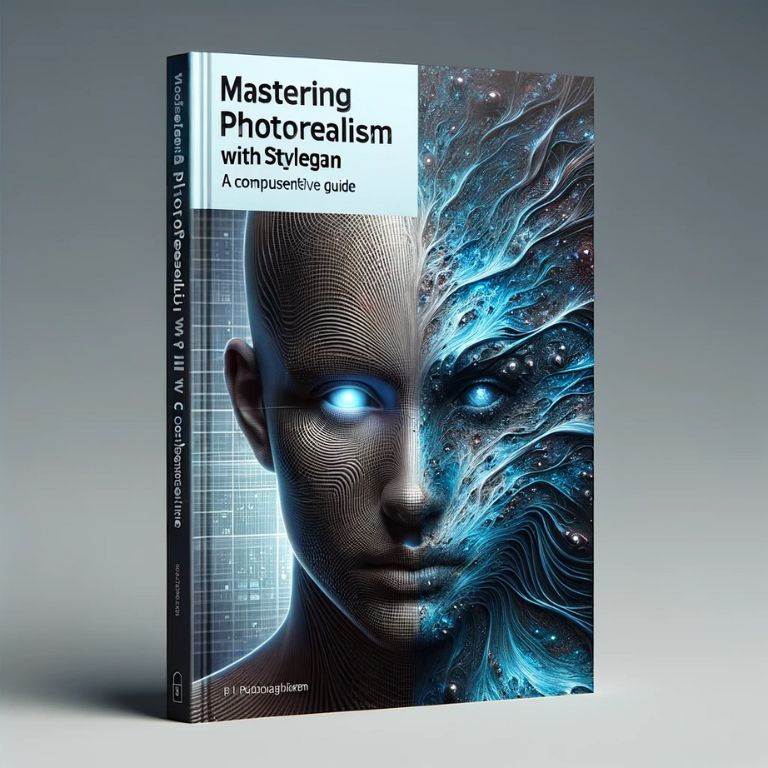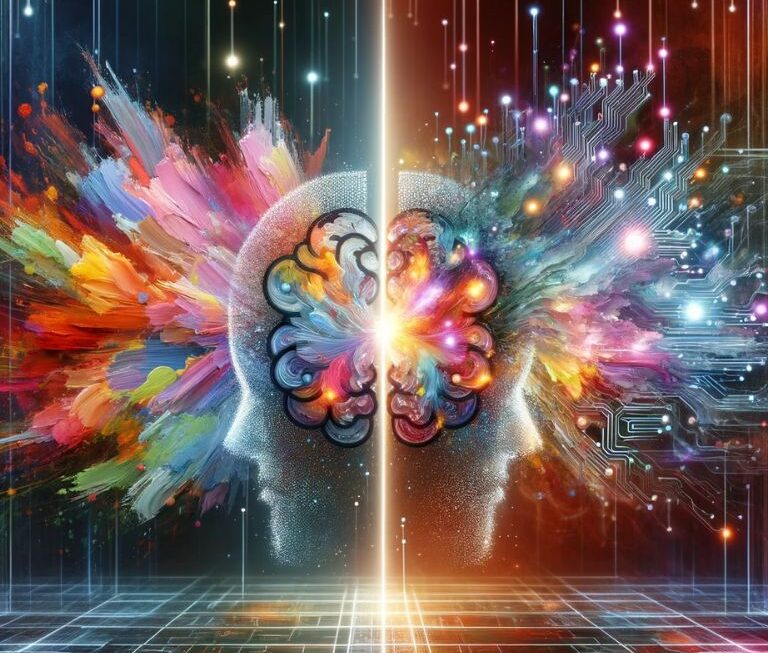In the ever-evolving world of artificial intelligence and machine learning, one of the most stunning advancements has been the development of Generative Adversarial Networks (GANs), with StyleGAN at the forefront, revolutionizing the way we create and perceive images. This guide aims to explore the nuances of StyleGAN, a style-based generative network, and its unparalleled capability in generating high-resolution, photorealistic images.
Understanding StyleGAN
What is StyleGAN?
StyleGAN, developed by NVIDIA, represents a significant advancement in the field of Generative Adversarial Networks (GANs). GANs themselves are a revolutionary concept in artificial intelligence, where two neural networks, a generator and a discriminator, are pitted against each other to create new, synthetic instances of data that are indistinguishable from real data. StyleGAN builds upon this foundation with a focus on generating highly realistic and high-resolution images.
Evolution of StyleGAN:
- Original GANs: The initial GAN models were groundbreaking in generating new data, but they had limitations in terms of image quality and resolution.
- Introduction of StyleGAN: StyleGAN was introduced to address these limitations, particularly in generating photorealistic images. It brought a new architecture that allowed unprecedented control over the style of generated images.
Key Features of StyleGAN
StyleGAN is distinguished by several key features that set it apart from its predecessors:
Advanced Style Control:
- Layered Style Injection: StyleGAN introduces a novel way of controlling the style of generated images by injecting style at various layers of the generator network. This allows for precise control over various aspects of the image, from coarse features like the overall shape to fine details like textures.
High-Resolution Image Synthesis:
- Improved Image Quality: One of the most notable achievements of StyleGAN is its ability to produce high-resolution images that are remarkably lifelike. This is a significant step up from earlier GAN models, which struggled with maintaining image quality at higher resolutions.
Improved Training Stability:
- Stabilized Training Process: Training GANs has traditionally been challenging due to issues like mode collapse, where the generator produces limited varieties of output. StyleGAN introduces techniques that make the training process more stable and reliable.
Versatility in Applications:
- Wide Range of Uses: The ability of StyleGAN to generate photorealistic images has found applications in numerous fields, from creating virtual models for fashion and design to generating realistic human faces for identification and entertainment purposes.
Understanding StyleGAN is crucial for appreciating its impact on the field of AI-driven image generation. Its advanced style control, capability to produce high-resolution images, and improved training stability mark significant progress in the journey towards creating ever more realistic synthetic images. This technology not only enhances the capabilities of artists and designers but also opens up new possibilities in how we interact with and utilize AI-generated visual content.
The Technical Framework
Architecture of StyleGAN
The architecture of StyleGAN is what sets it apart from other generative adversarial networks, allowing it to produce high-quality, photorealistic images. Understanding this architecture is key to comprehending how StyleGAN achieves its impressive results.
Layered Approach:
- Multiple Layers for Different Details: StyleGAN uses a progressive layering technique where different layers of the neural network contribute to different aspects of the image. Early layers affect major aspects like the overall shape and structure, while deeper layers influence finer details like texture and color nuances.
Style and Noise Injection Mechanism:
- Control Over Image Generation: A unique feature of StyleGAN is its ability to inject style and random noise at different layers of the generator. This style injection controls how features at different scales are manifested, while the noise adds minor variations that contribute to the realism of the images.
Mapping Network:
- Translating Input to Style: StyleGAN includes a mapping network that transforms input latent codes into intermediate latent variables. These variables are then used to control the style at different layers, enabling intricate control over the generated images.
Training Process

The training process of StyleGAN is a critical component that determines the quality and effectiveness of the generated images. This process involves several steps and considerations:
Dataset Requirements:
- High-Quality Data: For StyleGAN to generate high-resolution images, it requires a dataset of high-quality images. The larger and more varied the dataset, the better the model becomes at generating diverse and realistic images.
Training Methodology:
- Progressive Growing of GANs: StyleGAN utilizes a progressive growing methodology where it starts by training on low-resolution images and gradually increases the resolution as training progresses. This method improves the stability and speed of the training process.
Training Phases:
- Generator and Discriminator Training: In typical GAN fashion, the generator (which creates images) and the discriminator (which evaluates them) are trained simultaneously. The generator learns to produce more realistic images, while the discriminator becomes better at distinguishing real images from generated ones.
Optimization and Loss Functions:
- Balancing Generator and Discriminator: StyleGAN uses specific optimization and loss functions to balance the training of the generator and the discriminator. This is crucial to prevent issues like mode collapse and to ensure the generation of varied and high-quality images.
The technical framework of StyleGAN, encompassing its unique architecture and sophisticated training process, is foundational to its ability to create photorealistic images. The architecture’s layered approach, combined with the style and noise injection mechanisms, allows for unprecedented control over image generation. Meanwhile, the careful design of the training process ensures that the model learns effectively from high-quality datasets, resulting in stunningly realistic outputs. Understanding these technicalities offers insight into the power of StyleGAN and its potential applications in various fields.
Style Manipulation in Depth
Controlling Image Attributes
StyleGAN’s innovative architecture allows for detailed control over various image attributes, making it a powerful tool for generating photorealistic images. This section delves into how StyleGAN manipulates key attributes such as style, texture, and color.
Manipulating Style:
- Distinctive Style Features: StyleGAN can manipulate high-level attributes of an image, such as the style of hair in portraits or the overall aesthetic of a landscape. This is achieved through its unique style injection mechanism, where different layers of the neural network are responsible for different scales of style features.
- Fine-grained Control: Users can exert control over specific aspects of style in the generated images, allowing for customization and variations that are not possible with traditional GANs.
Texture and Color Manipulation:
- Texture Detailing: The deeper layers of StyleGAN are adept at manipulating the texture of objects in the images, giving them a realistic and tangible quality. This includes details like skin texture in faces or the intricacies of clothing fabric.
- Color Variations: StyleGAN also allows for the manipulation of color tones and schemes, enabling the generation of images that not only have realistic textures but also accurate and lifelike colors.
Applications in Photorealism
The capabilities of StyleGAN in controlling style, texture, and color have opened up new avenues in photorealistic image generation, finding applications in various fields.
Realistic Portraits and Art Creation:
- Human Portraits: StyleGAN is widely used to create photorealistic portraits of humans that do not exist in reality, a tool that can be invaluable for artists and designers.
- Art and Fashion Design: The technology is also being used in the fields of art and fashion, where designers can visualize clothing, accessories, and artworks in a highly realistic manner without the need for physical prototypes.
Entertainment and Media:
- Character Design: In the entertainment industry, StyleGAN assists in creating detailed and lifelike characters for movies, video games, and animation.
- Virtual Models and Influencers: The technology is also behind the creation of virtual models and influencers, which are becoming increasingly popular in digital marketing and social media.
The ability of StyleGAN to manipulate image attributes like style, texture, and color with such a high degree of control and realism is a breakthrough in the field of AI-driven image generation. This capability has wide-ranging applications, from art and design to entertainment and marketing, demonstrating the versatile potential of StyleGAN in various industries. By harnessing this technology, creators and innovators can push the boundaries of photorealism, opening up new realms of creativity and visual communication.
Step-by-Step Guide to Implementing StyleGAN
Setting Up the Environment
Before diving into the practical implementation of StyleGAN, it is crucial to set up an appropriate environment that meets the necessary hardware and software requirements.
Hardware Requirements:
- GPU Support: StyleGAN requires a significant amount of computational power, ideally an NVIDIA GPU with CUDA support. This is essential for training the model efficiently.
- RAM: At least 16GB of RAM is recommended for smooth operation.
Software Requirements:
- Operating System: A Linux-based OS is preferred, although Windows can also be used.
- Python: Python 3.6 or newer.
- Deep Learning Libraries: TensorFlow 1.15 or 2.x, Keras (for TensorFlow 2.x compatibility).
Installation Steps:
- Install Python: Ensure Python 3.6 or newer is installed. Python can be downloaded from the official website.
- Set Up a Virtual Environment (optional but recommended): This keeps dependencies organized and separate from other projects. Use
python3 -m venv stylegan-venvto create a virtual environment and activate it withsource stylegan-venv/bin/activate. - Install TensorFlow: Use
pip install tensorflow-gpu==1.15(for GPU support) orpip install tensorflow==1.15(for CPU-only). - Install Other Dependencies: Install necessary libraries like numpy, pandas, etc., using
pip install [library-name].
Training Your Own StyleGAN Model

Training your StyleGAN model involves several steps, from preparing your dataset to the actual training process.
Preparing Your Dataset:
- Collect Images: Gather a large set of images relevant to what you want to generate. The more diverse and high-quality the dataset, the better the results.
- Preprocess Images: Ensure all images are of the same resolution and format. Typically, StyleGAN works with 1024×1024 pixels. Tools like OpenCV or PIL in Python can help with resizing and formatting.
Training Process:
- Download StyleGAN Code: NVIDIA’s official StyleGAN repository is available on GitHub. Clone it to your local environment.
- Configure Training Parameters: Adjust the training parameters in the code according to your dataset and requirements. This includes setting the image resolution, batch size, and learning rate.
- Start Training: Run the training script. This can be done using a command like
python run_training.py. Training a StyleGAN model can take several days, depending on your hardware capabilities.
Monitoring Training Progress:
- Use TensorBoard: This tool helps in visualizing the training progress, observing how the generated images evolve over time.
- Save Intermediate Models: Regularly save states of your model so you can revert to a previous state if needed.
Troubleshooting Common Issues:
- Out of Memory Errors: These occur often due to insufficient GPU memory. Try reducing the batch size or image resolution.
- Slow Training: This is usually hardware-related. Ensure your GPU is being utilized effectively.
Implementing StyleGAN can be a challenging yet rewarding experience. It requires a blend of the right hardware and software setup, a well-prepared dataset, and patience during the training process. With these steps, you’re well on your way to creating stunning, high-resolution, photorealistic images using one of the most advanced generative models available today. Remember, the quality of the output heavily depends on the quantity and variety of the training data, so investing time in dataset preparation is crucial.
Implementing in Python Software
Implementing it in Python involves a series of steps, from setting up the environment to training the StyleGAN model. Below is a simplified example of how you can approach this in Python. Note that this is a high-level overview, and actual implementation details may vary based on your specific requirements and setup.
1. Setting Up the Environment
First, you need to set up your Python environment. You can do this using virtual environments, which help manage dependencies.
# Assuming Python 3 is already installed
# Create a virtual environment
python -m venv stylegan-venv
# Activate the virtual environment
# For Windows: stylegan-venv\Scripts\activate
# For Unix or MacOS: source stylegan-venv/bin/activate
# Install TensorFlow (assuming a GPU is available)
pip install tensorflow-gpu==1.15
# Install other necessary libraries
pip install numpy pandas opencv-python
2. Preparing Your Dataset
Prepare your dataset by collecting and preprocessing images. This can involve resizing images to a uniform size and format.
import cv2
import os
def preprocess_images(input_folder, output_folder, size=(1024, 1024)):
if not os.path.exists(output_folder):
os.makedirs(output_folder)
for filename in os.listdir(input_folder):
path = os.path.join(input_folder, filename)
img = cv2.imread(path)
img = cv2.resize(img, size)
cv2.imwrite(os.path.join(output_folder, filename), img)
# Example usage
preprocess_images('path/to/raw/images', 'path/to/preprocessed/images')
3. Training the StyleGAN Model
For training the StyleGAN model, you would typically use the StyleGAN code provided by NVIDIA. This involves cloning their repository and using their scripts for training.
# Clone StyleGAN repository
git clone https://github.com/NVlabs/stylegan.git
# Navigate into the repository
cd stylegan
# Run the training script with necessary parameters
python run_training.py [additional parameters]
This step is quite complex and requires careful configuration of the training parameters. You’ll need to adjust the training script according to your dataset and hardware capabilities.
4. Monitoring Training Progress
You can use TensorBoard to monitor the training progress. This can be set up to run alongside your training process.
tensorboard --logdir=path/to/log_directory
This is a basic outline of how you could implement a StyleGAN project in Python. The actual implementation can get quite complex, especially when it comes to training the model and fine-tuning the parameters. Also, keep in mind that training a StyleGAN model requires substantial computational resources, typically a powerful GPU. The code snippets provided here are for guidance and would need to be adapted to your specific project requirements.
Embracing the Future: Balancing Innovation and Ethics in StyleGAN Technology
The exploration of StyleGAN in this comprehensive guide reveals its remarkable capabilities in the realm of photorealistic image generation. From its advanced architecture that allows intricate manipulation of style, texture, and color, to its powerful applications in various industries, StyleGAN stands as a testament to the incredible advancements in the field of artificial intelligence and machine learning. The step-by-step guide offers a practical approach to implementing StyleGAN, illuminating the path for enthusiasts and professionals alike to harness this technology. However, it’s not just the technical prowess that makes StyleGAN significant; the ethical considerations it raises are equally important. As we embrace this technology, it’s crucial to navigate its applications responsibly, understanding the implications it has on privacy, consent, and the authenticity of digital media.
Looking forward, the potential of StyleGAN and similar technologies is vast, promising further innovations in image generation and beyond. The intersection of AI with creativity opens up new horizons for artists, designers, and creators, offering tools that were once the realm of imagination. Yet, as we venture into this new era, the balance between technological advancement and ethical responsibility remains paramount. The future of StyleGAN, while bright and full of possibilities, will be shaped not only by the advancements in algorithms and computational power but also by the collective commitment to using this technology for the betterment of society, upholding values of integrity and authenticity in the digital world.




